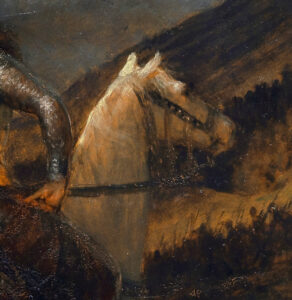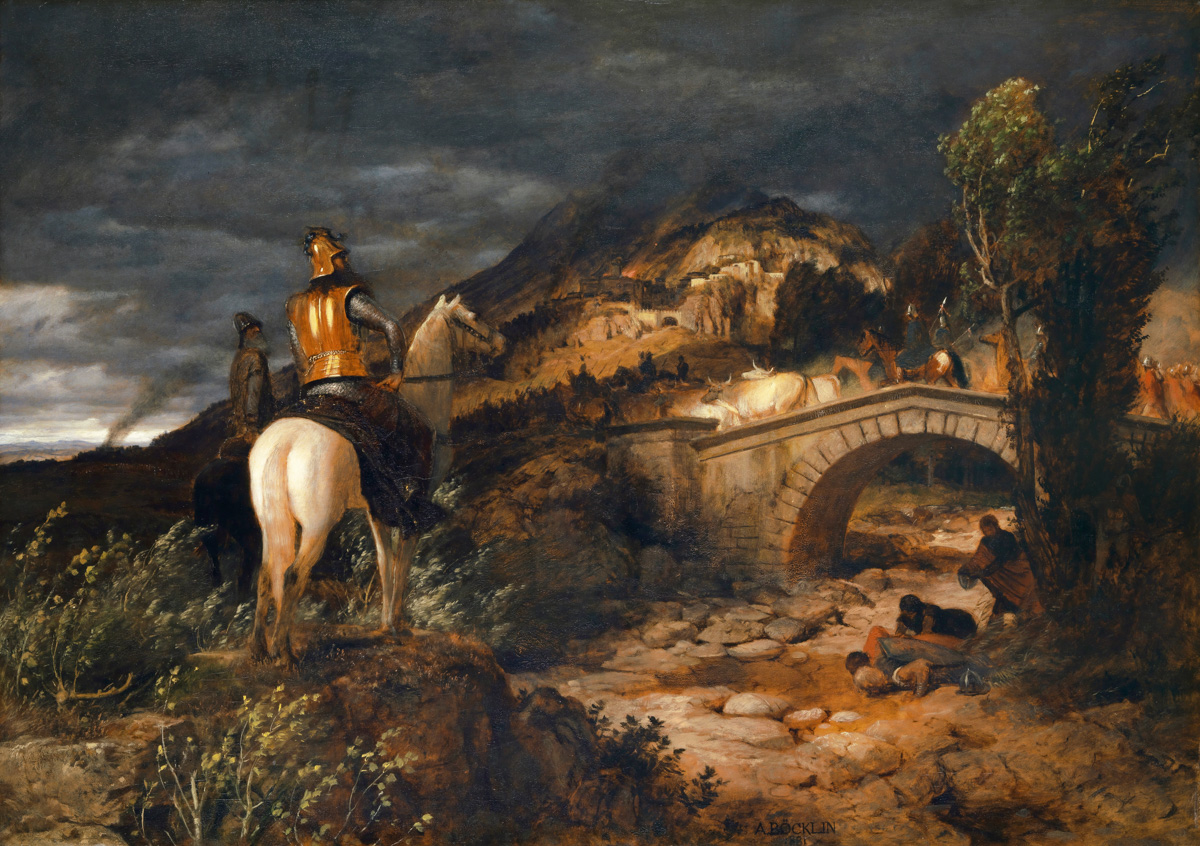Athens, Rome, & the
Nameless North


Dr. Ben Reinhard
The classical education movement, it may be observed, is enjoying something of a moment. It was not always so: for generations, the American educational establishment neglected liberal education (in favor of vocational training and STEM), and derided the western canon in the name of diversity and multi-culturalism. But recent years have seen that same establishment begin to collapse, like an octopus dragged to land, under its own bloated weight. With the corruption and incompetence of the establishment now visible to all with eyes to see, its newly liberated subjects have good reason to seek an alternative. And that alternative is, increasingly, classical.
Naturally, those institutions strongly identified with classical education stand to reap the benefits. Thus, while the rest of the nation reckons with plummeting enrollments and institutional closures, Hillsdale College reports record applications every year, and its Catholic counterparts are similarly thriving. The Classical Learning Test has emerged as a viable alternative to the SAT and ACT; the networks of Chesterton Academies and Great Hearts Academies are exploding; graduate schools in classical education are sprouting up like mushrooms after a spring rain. And this is not strictly an American phenomenon (as institutions such as Hungary’s Mathias Corvinus Collegium and Poland’s Collegium Intermarium demonstrate).
All these institutions succeed because of their recognized commitment to classical education: so far, so good. But what is classical education? No universally accepted definition exists, but it is possible to arrive at a satisfactory generalization by something like triangulation. Thus we observe Hillsdale College “considers itself a trustee of our Western philosophical and theological inheritance tracing to Athens and Jerusalem.” Memoria Press — a leading provider of classical curricula — likewise suggests that Western civilization consists “of three cultures: those of Athens, Rome, and Jerusalem Similarly, the Collegium Intermarium stands for “the classical values of European civilization: Roman legal culture, Greek philosophy and Christian ethics,” while the CiRCE Institute quotes with approval Tracy Simmons’ claim that classical education requires “a curriculum grounded upon . . . Greek, Latin and the study of the civilization from which they arose.” While many further examples could be supplied, this is sufficient to conclude that common usage strongly identifies classical education with Western civilization, and Western civilization with Greece, Rome, and (perhaps) Jerusalem.
Similarly, the Collegium Intermarium stands for “the classical values of European civilization: Roman legal culture, Greek philosophy and Christian ethics,” while the CiRCE Institute quotes with approval Tracy Simmons’ claim that classical education requires “a curriculum grounded upon . . . Greek, Latin and the study of the civilization from which they arose.” While many further examples could be supplied, this is sufficient to conclude that common usage strongly identifies classical education with Western civilization, and Western civilization with Greece, Rome, and (perhaps) Jerusalem.
The observant reader may well feel that there is something missing from this picture, but so complete is our cultural amnesia and so thorough our conditioning that he might struggle to articulate what, precisely, it is. The great Christian humanists of the mid-twentieth century (arguably the last generation to be educated according to the old classical model) operated under no such limitations, however, and are able to tell us exactly what the current model lacks: it lacks what we might call the Northern, or the barbarian, or even the Germanic.

The observant reader may well feel that there is something missing from this picture, but so complete is our cultural amnesia and so thorough our conditioning that he might struggle to articulate what, precisely, it is.

This is admittedly something of a counterintuitive claim (it was after all the invasion of the Germanic tribes — Franks and Angles, Saxons and Jutes, Visigoths and Ostrogoths — that brought the old classical order to an end in the West) and certainly an uncomfortable one (the obvious monstrosities of the Nazi racialist doctrine rendered any discussion of Germanitas potentially dangerous and certainly embarrassing). But the classical education movement has always prioritized truth over expediency. Granted, Renaissance propagandists and Enlightenment philosophes viewed themselves as the heirs of Greece and Rome and saw nothing of value in the Middle Ages. For Voltaire, they offered the historian nothing but “the barren prospect of a thousand years of stupidity and ignorance”; for Alexander Pope, they were the age of tyranny and superstition joined. But can we really agree with this assessment, maintaining that the flourishing of Christendom, the rise of the modern European nations, and the maturation of Western Civilization were achieved without any influences or cultural inputs other than those of early antiquity?
The greatest scholars and teachers of the twentieth century did not think so. Thus, though he allowed the primacy of “classical culture and Christian religion” as “the two great traditions that have contributed most to the development of Western civilization,” Christopher Dawson noted in The Crisis of Western Education that “there is also a third element . . . the autochthonous tradition of the Western peoples themselves,” rooted in the soil and culture of barbarian Europe. Dawson believed that no account of Western culture could be complete without this barbarian element and urged his fellow educators to make some room for it in their curricula.
 Romano Guardini recognized two great advents in the course of European history. The first was, of course, the coming of Christianity. The second? “[T]he Germanic essence entering history.” According to Guardini, the Germans brought an “inwardness . . . the basis of a new way of seeing and grasping the world”; in his End of the Modern World, he describes this Germanitas as essential to the Christian understanding of the world. “Deeply significant for the new religious outlook of medieval man was the influx of the Germanic spirit. The religious bent of the Nordic myths, the restlessness of the migrating peoples and the armed marches of the Germanic tribes revealed a new spirit which burst everywhere into history like a spear thrust into the infinite. This mobile and nervous soul worked itself into the Christian affirmation. There it grew mightily. In its fullness it produced that immense medieval drive which aimed at cracking the boundaries of the world.” For Guardini, the arrival of the Germanic tribes in the Roman empire was less destruction than it was liberation. “Only after the Germanic ferment had quickened the European world throughout the course and aftermath of the migrations was man’s relation to God freed from the boundaries fixed by antiquity.”
Romano Guardini recognized two great advents in the course of European history. The first was, of course, the coming of Christianity. The second? “[T]he Germanic essence entering history.” According to Guardini, the Germans brought an “inwardness . . . the basis of a new way of seeing and grasping the world”; in his End of the Modern World, he describes this Germanitas as essential to the Christian understanding of the world. “Deeply significant for the new religious outlook of medieval man was the influx of the Germanic spirit. The religious bent of the Nordic myths, the restlessness of the migrating peoples and the armed marches of the Germanic tribes revealed a new spirit which burst everywhere into history like a spear thrust into the infinite. This mobile and nervous soul worked itself into the Christian affirmation. There it grew mightily. In its fullness it produced that immense medieval drive which aimed at cracking the boundaries of the world.” For Guardini, the arrival of the Germanic tribes in the Roman empire was less destruction than it was liberation. “Only after the Germanic ferment had quickened the European world throughout the course and aftermath of the migrations was man’s relation to God freed from the boundaries fixed by antiquity.”
These sentiments were echoed by some of the classical education movement’s most beloved luminaries. When C. S. Lewis outlined his ideal English curriculum, he was willing to jettison all manner of things regarded as essential by the classical education movement — including Latin and Greek — but maintained in his essay “Our English Syllabus” that “the tap-root, Anglo-Saxon, can never be abandoned. The man who does not know it remains all his life a child among real English students.” And in his Roots of American Order, Russell Kirk suggested that a fourth city — London — be added to the Athens, Rome, and Jerusalem, as a representative of the medieval patrimony, which “is more immediately related to American institutions and even American thought than is the legacy of Greece and Rome.”
For all this, the greatest defender and exponent of “the ‘Germanic’ ideal” was (perhaps not surprisingly) J. R. R. Tolkien: his personal, professional, and imaginative lives all centered on what he called “that noble northern spirit, a supreme contribution to Europe, which I have ever loved, and tried to present in its true light.” Thus, in 1928, Tolkien read an essay — “The Chill Barbarians of the North” — to the Oxford Newman society. Though the essay has not survived, The Tablet reported that Tolkien “criticized the views associated with Mr. Belloc and maintained that Northern culture was quite as real as the Latin.” His 1936 British Academy lecture on Beowulf established the poem as a worthy object of literary study and an exemplar of “the Northern courage . . . which is the great contribution of early Northern literature.” His academic work, naturally enough, seeped into his creative fiction as well. Tolkien tinkered with novels in which he satirized German-despising classicists (The Notion Club Papers) — and of course The Hobbit and The Lord of the Rings are heavily infused with Tolkien’s theory of “Northernness.”
Thus the great Christian educators of the early and mid-twentieth century demand that the Germanic element be given its due. Today’s classical educators would do well to heed their counsel. Put simply, to attempt to tell the story of Western civilization and neglect the Germanic and the medieval is to commit oneself to absurd admissions in both history and literature: as in the literature textbook I once owned that refused to acknowledge any meaningful literature between Augustine and Dante. Even more importantly, we lose the ability to offer anything like a comprehensive and coherent account of Christian civilization. The barbarians of Gaul, Britain, the Germanies, and the Mediterranean provided the raw material from which Christendom was constructed — as well as many of its principle earthly architects. As Dom Prosper Guéranger notes in The Liturgical Year, they were the means by which the Holy Spirit renewed the earth, transforming the old static order of Rome into something more dynamic, capacious, and humane — and, dare we say it, more Christian. Likewise, Guardini observes that the Germanic element enabled Western man “to scale the barriers of the world and reach into the infinite that he might embrace the Godhead and return from him to make all things new.” The result was, as Dawson claims, the “Christian culture par excellence . . . the only great culture that we know which was created by Christian forces and directed towards Christian ends.”

Thus the great Christian educators of the early and mid-twentieth century demand that the Germanic element be given its due. Today’s classical educators would do well to heed their counsel.

This brings us to the final danger of the neglect of the Germans: one less purely intellectual than it is spiritual. The Germans really did bring something new — for Guardini, an ‘inwardness’; for Lewis, ‘romanticism’; for Tolkien, ‘courage’ — into the world. We neglect this at our peril. In the first place, to idealize Western civilization and ignore this wandering, restless, and questing element is to idolize a distortion: one that overemphasizes a pseudo-classical rigidity and stability. Given the universal human tendency to become what we admire, this is no small danger. But perhaps even more dangerous than embracing a falsehood is rejecting a truth — and the truth represented by Tolkien’s “noble northern spirit” is one that students of our chaotic century desperately need. On its own, pure classicism will not give them the strength to conquer the frost giants, ettins, and ogres of the emerging dark age. But the full tale of western civilization — with due attention to the previously neglected North — may.


